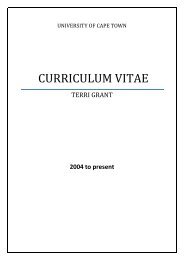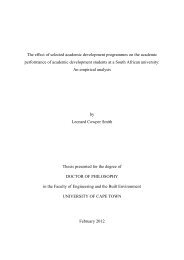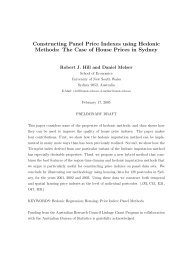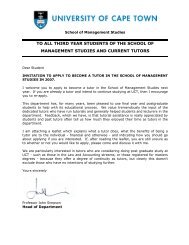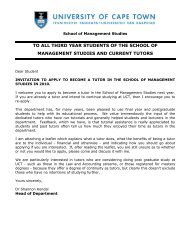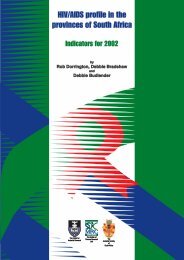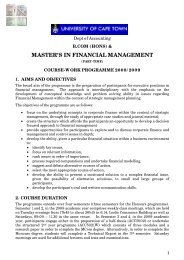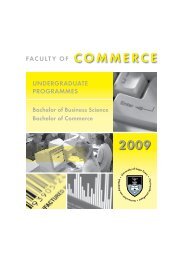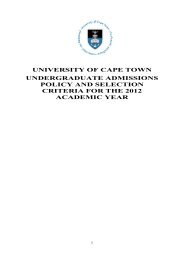Competition and Regulation in the Telecommunications Industry in ...
Competition and Regulation in the Telecommunications Industry in ...
Competition and Regulation in the Telecommunications Industry in ...
You also want an ePaper? Increase the reach of your titles
YUMPU automatically turns print PDFs into web optimized ePapers that Google loves.
<strong>Competition</strong> <strong>and</strong> <strong>Regulation</strong> <strong>in</strong> <strong>Telecommunications</strong>4.3.3 ContestabilityThe primary barrier to entry for network <strong>and</strong> service provision is of course <strong>the</strong>regulated monopoly. Aga<strong>in</strong> <strong>the</strong> key question is how will <strong>the</strong> market change ifentry was liberalised. In answer<strong>in</strong>g this question for long-distance, it isimportant to separate <strong>the</strong> network provision from <strong>the</strong> service provision, as <strong>the</strong>barriers to entry are considerably different. Entry can also be partial orcomplete. Partial may <strong>in</strong>clude bus<strong>in</strong>ess or metropolitan areas only, whilecomplete would <strong>in</strong>clude a national service.Barriers to entryThe barriers to entry for network providers <strong>in</strong>clude:• Sunk costs – <strong>the</strong> long distance network has fewer sunk costs to a full localaccess network. In addition, long distance is not considered a naturalmonopoly because excess capacity is not a problem. The collect<strong>in</strong>g oflocal traffic <strong>and</strong> funnell<strong>in</strong>g it down a s<strong>in</strong>gle long distance network ensureshigher capacity utilisation <strong>and</strong> scope for more than one network toprofitably exist.The level of sunk costs for long-distance networks can be more easilylowered than <strong>in</strong> local access. First, <strong>the</strong>re are more established networksdeliver<strong>in</strong>g o<strong>the</strong>r services mak<strong>in</strong>g economies of scope possible (<strong>in</strong>cluderailway, electricity). Also, satellite is a viable alternative to fixed l<strong>in</strong>e givenhigh capacity utilisation rates. F<strong>in</strong>ally, <strong>in</strong> South Africa <strong>the</strong>re exist privatenetworks with a national long-distance network already <strong>in</strong>stalled that hasspare capacity. The <strong>in</strong>cremental cost of provid<strong>in</strong>g <strong>the</strong> service to localaccess subscribers <strong>in</strong>volves provid<strong>in</strong>g a po<strong>in</strong>t-of-presence (PoP) switch<strong>and</strong> extend<strong>in</strong>g <strong>the</strong> network to areas that are not covered yet.The sunk costs can be lowered for <strong>in</strong>itial entry if <strong>the</strong> entrant is able to leasecapacity from <strong>the</strong> <strong>in</strong>cumbent on entry while <strong>the</strong>y roll out a more completenetwork (those that <strong>in</strong>tend gett<strong>in</strong>g a full network). This is <strong>the</strong> equivalentissue to allow a new mobile network operator to roam on exist<strong>in</strong>g networksdur<strong>in</strong>g <strong>the</strong> rollout period.• Customer switch<strong>in</strong>g costs – customer switch<strong>in</strong>g costs between longdistance networks are focused on <strong>the</strong> diall<strong>in</strong>g process. If <strong>the</strong>re are morethan one long-distance providers, <strong>the</strong>n it is necessary for <strong>the</strong> subscriber tomake <strong>the</strong> choice. Given that <strong>the</strong> <strong>in</strong>cumbent is go<strong>in</strong>g to be <strong>the</strong> naturaldefault if no specific choice is made (because <strong>the</strong>y own <strong>the</strong> local accessnetwork), this offers <strong>the</strong> <strong>in</strong>cumbent a dist<strong>in</strong>ct advantage over compet<strong>in</strong>gnetworks. The worst possible scenario is if <strong>the</strong> customer has an <strong>in</strong>cumbentdefault <strong>and</strong> needs to tap <strong>in</strong> an access code to use a compet<strong>in</strong>g longdistance provider. The longer this code is, <strong>the</strong> higher are <strong>the</strong> switch<strong>in</strong>gcosts.The least distortionary means is to have <strong>the</strong> customer pre-select <strong>the</strong> longdistanceprovider of choice <strong>and</strong> <strong>the</strong>n any long-distance call without anaccess code will be routed through <strong>the</strong>ir network of choice. If <strong>the</strong>subscriber wishes to override <strong>the</strong>ir selection, <strong>the</strong>n <strong>the</strong> access code can beused. However, it is preferable that as short as possible access code isused to limit switch<strong>in</strong>g costs.43



